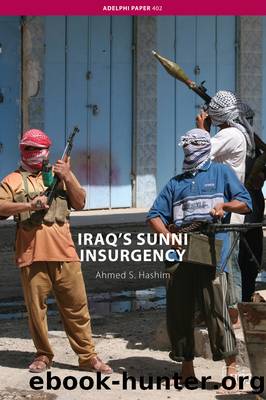Iraq's Sunni Insurgency by Ahmed S. Hashim

Author:Ahmed S. Hashim [Hashim, Ahmed S.]
Language: eng
Format: epub
Tags: Mathematics, Applied, Political Science, Security (National & International)
ISBN: 9780415466554
Google: vaXD-fMgEXMC
Publisher: Routledge
Published: 2009-01-15T01:17:33+00:00
Chapter Five
The Insurgencyâs Internal and External Problems
The insurgency in Iraq is largely Sunni Arab, despite the fact that Sunni Arabs only account for around 17% of the population. Partly as a result of this, the insurgency suffers from severe weaknesses. It has never been able to transcend the parochial and particularistic interests of Iraqâs various communities. Even when the country appeared to be on the verge of a genuine national uprising in 2004, when elements of the Shia population mobilised under the leadership of cleric Moqtada al-Sadr, the potential for unity was less than many hoped, despite the claims of some Iraqis that, at last, their country was reacting in a unified national way to the foreign presence.1 As became clear, al-Sadr was not rising in support of the Sunnis, nor was there any coordination with Sunni insurgent groups except at the very lowest tactical levels.
The insurgencyâs lack of unity, reflected in the existence of myriad groups, has had a negative impact on mobilisation, organisational coherence, the promotion of an effective ideology of resistance and the articulation of goals to which all Iraqis could subscribe. Moreover, the insurgency has not succeeded in attracting effective international support, nor have its members been able to find sanctuary abroad.
Not a National War of Liberation
The insurgency in Iraq is not a national-liberation struggle in the traditional sense of a war against an occupying power. It may be perceived as such by much of the Sunni community, but the insurgency has failed to move beyond its ideological parochialism to incorporate other Iraqis. Indeed, it has contributed, along with other elements in the country, to sectarian divisions and thus to national disunity. There is extensive active and passive support for the insurgency within the Sunni Arab community, support which has increased since the emergence of the Shiâites as the major political force in the country2 â though it is important to remember that not all Sunnis have taken up arms, and many are involved peaceably in the political process.
None of Iraqâs other ethno-sectarian communities is as heavily involved in the insurgency. Sunni Kurds make up around 18% of the countryâs population and Shia Arabs constitute roughly 60%. The remaining 6% comprises Turkmen, Christians and other groups. These figures are vigorously disputed, particularly by Sunni Arabs and Turkmen, many of whom are convinced that Shiâite numbers are inflated. Sunnis often complain that the Coalition exaggerates the demographic weight of the Shiâites for political reasons, and many Sunni Arabs claim that they constitute a majority, sometimes boosting their communityâs numbers by including Kurds and Sunni Turkmen in their count. However, a supposed demographic superiority is not the Sunnisâ main argument for why they ought to have preponderant power. The claim that the Sunnis âbuiltâ Iraq, and that the country therefore âbelongs toâ them is a popular one in Sunni circles in Iraq.3
Very few Kurds have taken up arms in support of the insurgency. For the great majority of Kurds, the US invasion represented liberation from the ever-present threat posed to their region, autonomous since 1991, by Saddamâs regime.
Download
This site does not store any files on its server. We only index and link to content provided by other sites. Please contact the content providers to delete copyright contents if any and email us, we'll remove relevant links or contents immediately.
Spell It Out by David Crystal(35347)
Life for Me Ain't Been No Crystal Stair by Susan Sheehan(35153)
Cecilia; Or, Memoirs of an Heiress — Volume 1 by Fanny Burney(31333)
Cecilia; Or, Memoirs of an Heiress — Volume 3 by Fanny Burney(30934)
Cecilia; Or, Memoirs of an Heiress — Volume 2 by Fanny Burney(30889)
Professional Troublemaker by Luvvie Ajayi Jones(28965)
The Great Music City by Andrea Baker(21318)
We're Going to Need More Wine by Gabrielle Union(18074)
Twilight of the Idols With the Antichrist and Ecce Homo by Friedrich Nietzsche(17707)
The Secret History by Donna Tartt(16627)
Cat's cradle by Kurt Vonnegut(13868)
Bombshells: Glamour Girls of a Lifetime by Sullivan Steve(13109)
Pimp by Iceberg Slim(12932)
All the Missing Girls by Megan Miranda(12752)
Fifty Shades Freed by E L James(12451)
Norse Mythology by Gaiman Neil(11883)
Talking to Strangers by Malcolm Gladwell(11879)
The Social Justice Warrior Handbook by Lisa De Pasquale(11489)
Underground: A Human History of the Worlds Beneath Our Feet by Will Hunt(11258)
